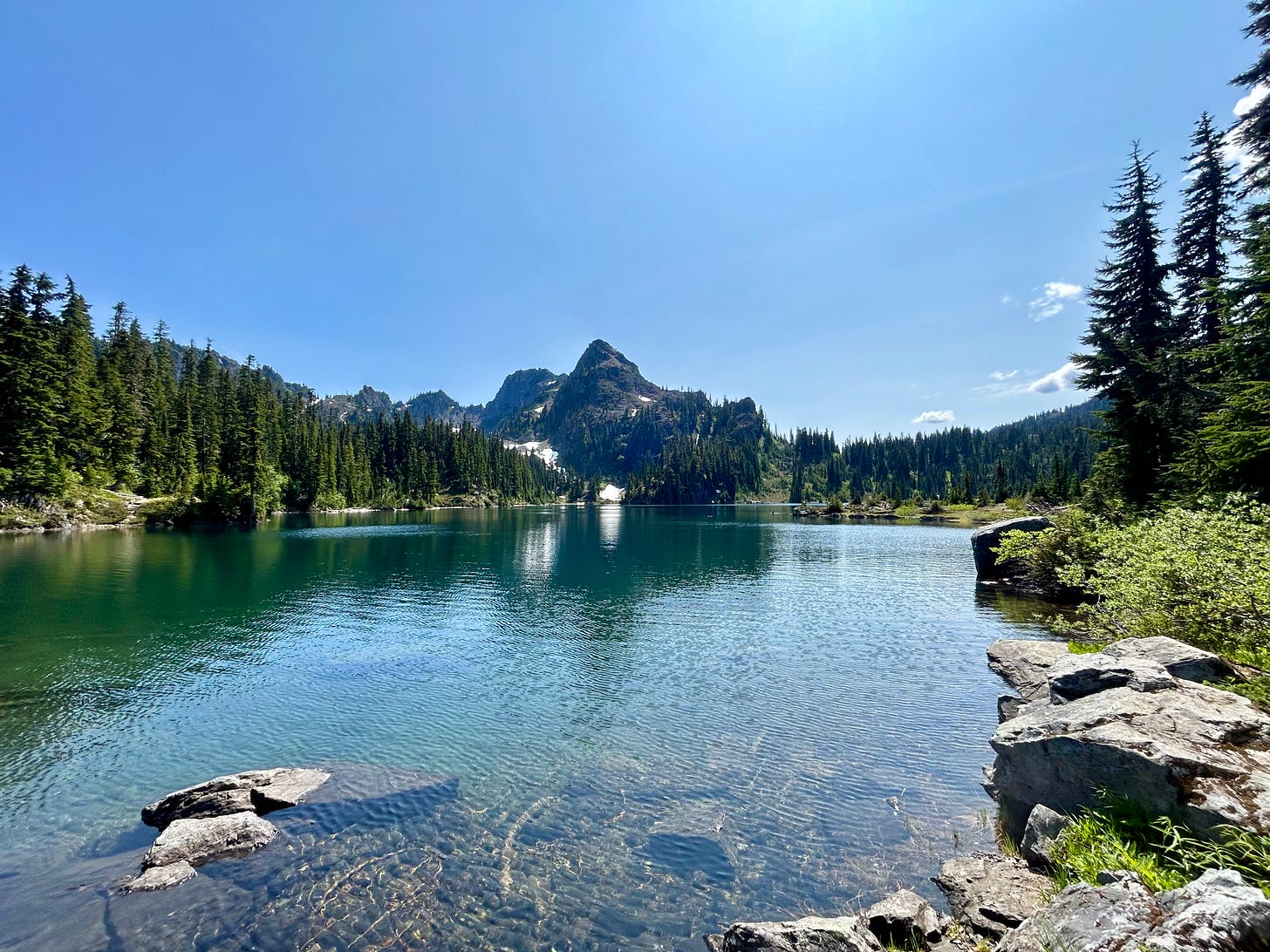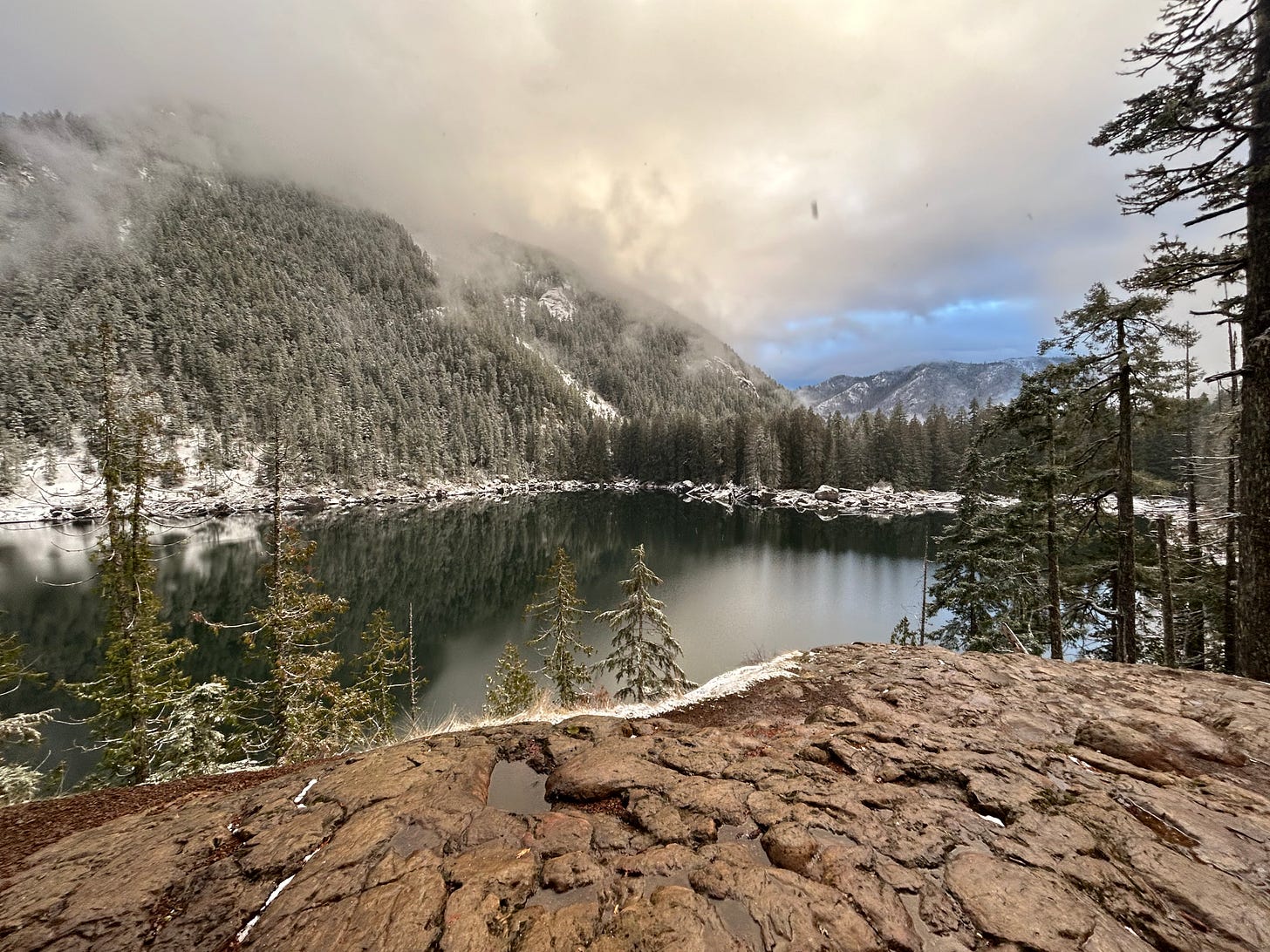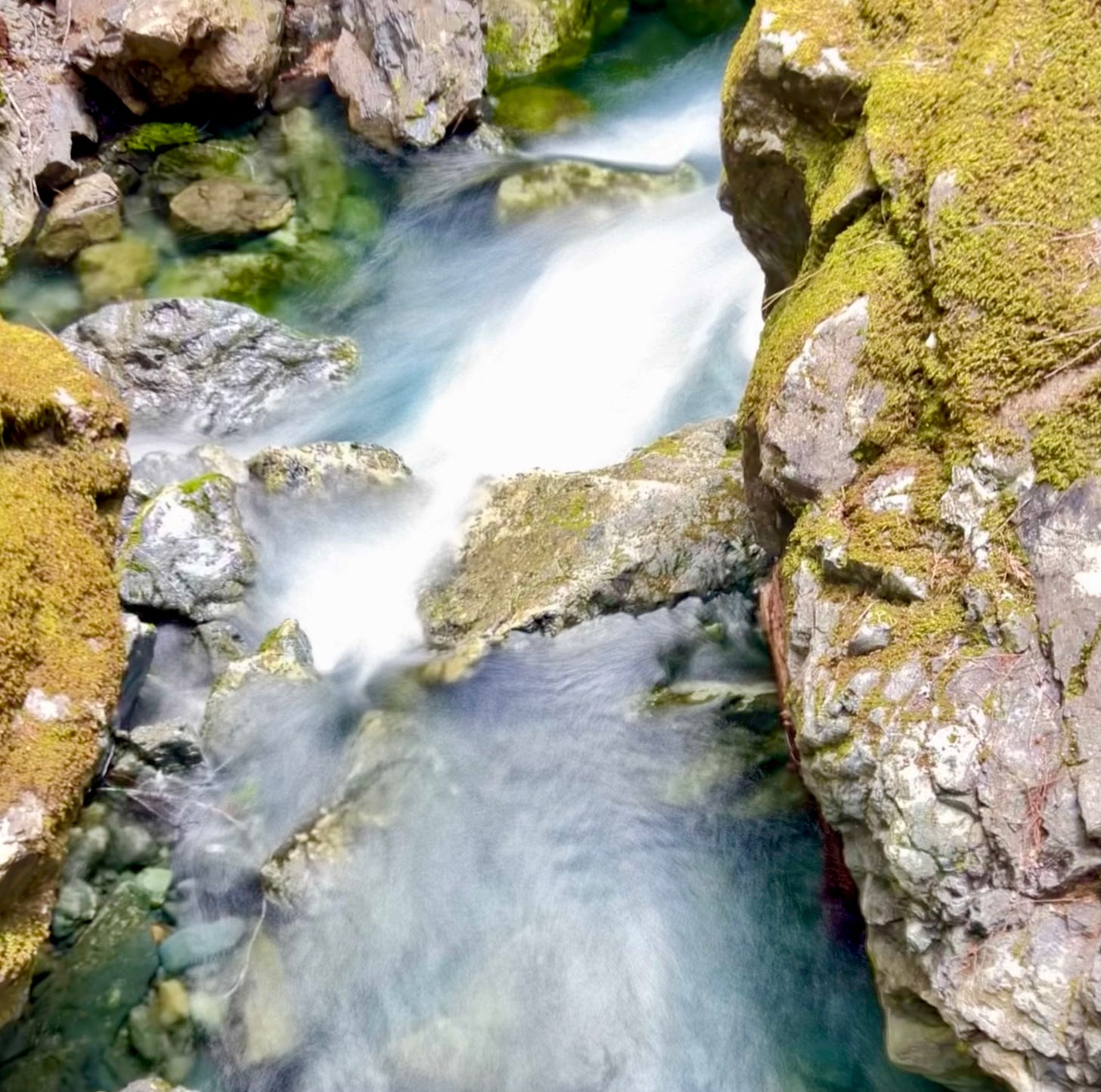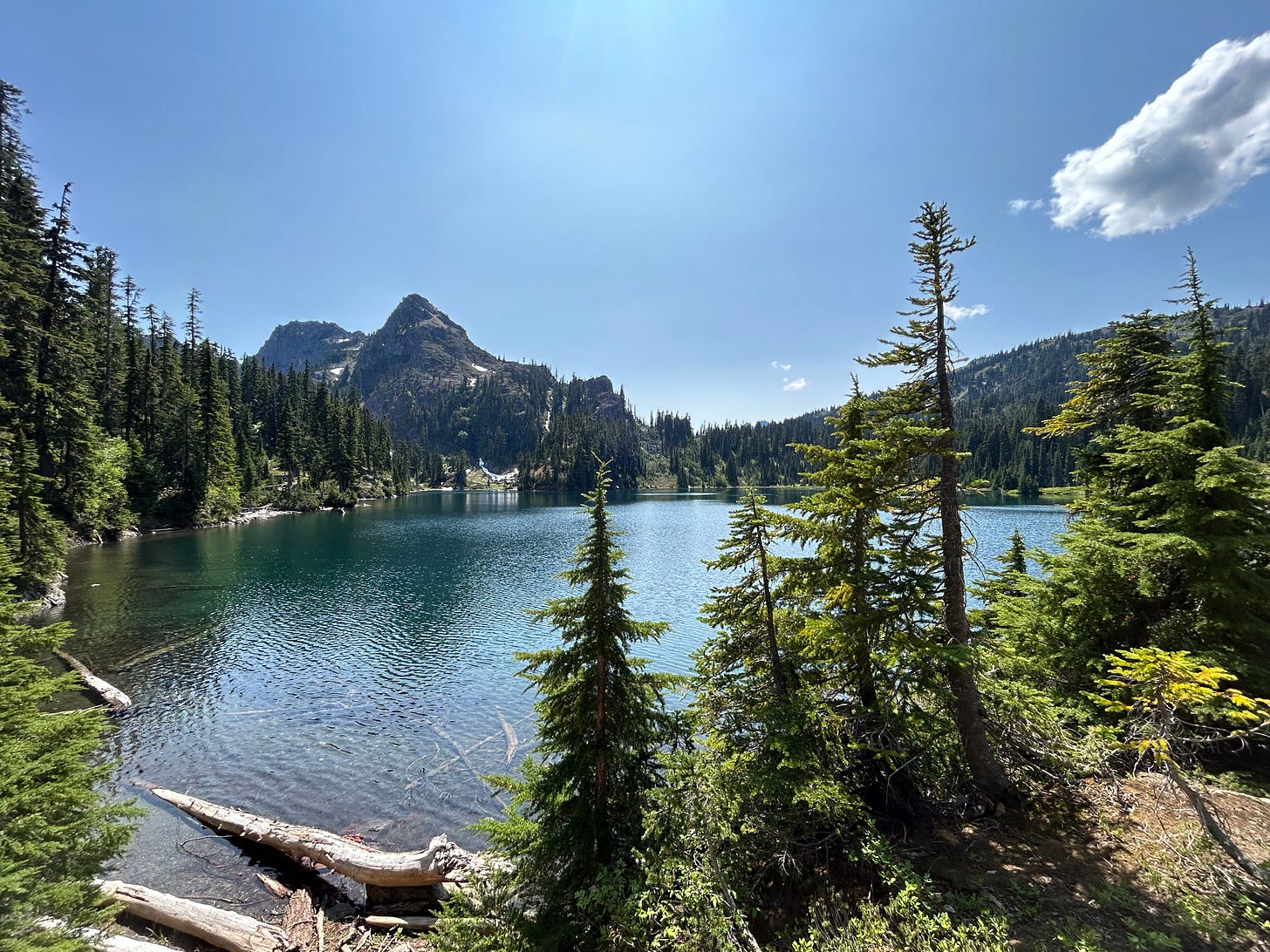Challenging Assumptions at Upper Lena Lake
48 hours of fasting + 14 miles + 4000 feet of elevation gain. What could go wrong? To my surprise, nothing actually did.
In the past few years, I have been making the unwanted discovery that a part of me — a very deep, forgotten part of me — resents food.
As someone who was quite sure she loved food, this has come as quite a surprise! In addition to being part of a family who plans their next meals while eating breakfast, I’ve long associated food with comfort and security, shared with loved ones and friends. Raised by an excellent cook (my mom) who expressed her affection through food, cooking was a way I could bring a homey sense of comfort to others as well: baking for all occasions (cakes for friends’ birthdays, cookies for crafting parties, muffins for morning work meetings), throwing multi-course dinner parties for friends, bringing salads to bbqs and picnics (I am rather known for the exceptional nature of my salads).
As such, for a very long time, “I LOVE FOOD” was my mantra. Even when my body began to sing a different tune — first showing up as guilt or shame about overindulgence, then as intolerance to a few foods, then more foods, then finally becoming full-blown allergic reactions — I still ignored everything but the trusted mantra, blaming my body for its intolerances and embarking on various restrictive diets until symptoms abated.
But in all of my experiments with diets, I never thought to look to my emotional reaction to food as a source of relevant information. That is, until I started fasting.
The first time I fasted was in my last twenties. My then-girlfriend’s boss was doing the “master cleanse” (no food for 3-10 days, only drinking water and a mix of lemon juice, maple syrup and cayenne pepper to maintain energy) and — inspired by his endurance — I opted to try it. I did it for three days and felt full of energy, but was also quite happy to start eating again. I found that I missed the rituals of food, as well as the social aspects of it — so many of my plans seemed to revolve around meeting up for a meal or drinks!
If I’d paid more attention at the time, I might have noticed that this was the first signal that while my body seemed fine — happier, even — without food, my mind had different opinions about the importance of food in my life.
But clearly, this experience started the gears turning, for over the next two decades, I would experiment with fasting — sometimes a day at a time, sometimes longer, with the longest being 13 days — enough to develop a fair amount of data about how my body felt and on water alone (there was even a particularly crazy interval where I went for 3.5 days without food or water, but I don’t recommend that for anyone — it was really just to prove that it could be done, but it was not terribly pleasant). While my energy levels varied depending on various inputs, the resounding conclusion was that I felt happier and, well, lighter without food in my life.
It was starting to seem that fasting brought me a sense of relief.
As someone who claimed to love food, I found this feeling of relief most fascinating, and I wanted to know more. So I began to ask myself what I was feeling relief from. The answers were both deep and surprising!
From fasting tests, I have found that:
The part of me who “loves” food is actually completely obsessed with it! From the moment I awake to the seconds that I’m falling asleep, I am thinking about what my next meal will be. Fasting provides a welcome relief from those thought-patterns and clears my mind for more productive thoughts and creativity.
Intriguingly, I have found that my people-pleasing empathic tendencies — that is, my proclivity to take on others’ feelings and desires as my own — tend to fade into the background during a fast. That is a welcome relief for sure!
In the absence of feeling others’ feelings, I can finally feel my own! (But as it turns out, not feeling them has been a coping strategy — more on that in future post.)
Based on standard assumptions about what can be accomplished while fasting, I tend to avoid strenuous exercise when on a water fast. However, I’ve been playing with this assumption more recently, discovering that I’ve actually found myself to have more physical energy when fasting than when not. I tested this out on Marmot Pass over Summer Solstice (hiking 5 miles and climbing 3500 feet while fasting for 24 hours, breaking fast on the trail when in need of energy for the last 0.75 mile), discovering that until that last mile, I felt better and hiked faster than my usual pace.
I began to wonder what would happen if I pushed that out to two days of hiking and fasting. Of course, I had trepidations: could I really make the 14 mile roundtrip, climbing almost 4000 feet?
In such moments, I consult with my higher self. This was no exception.
“Higher self,” I asked. “Can I really do this?”
The answer was an unequivocal YES, and the relief that flooded through my body was palpable. And even though my mind had trepidations, my body felt at peace with the idea.
So I went with it.
Packing for such a trip was quite easy, without any of the usual food prep. Without food-related provisions — including stove and bear canister — my backpack was blissfully light and easy to pack. And unlike my usual late hiking starts, I was able to be out the door and at the trailhead in no time.
As a primer on the trail itself, Lena Lake Trail is split into two sections:
Lower Lena Lake features a rare low-altitude alpine lake (1800ft), which is deep and beautiful and has several lovely campsites. Given its relatively short length (3.7 miles one-way) and moderate gain (1300ft), it is exceedingly popular with novice hikers, so much so that it turned into a kind of newbie-hiker superhighway during Covid years. The first time I went, it was a beautiful weekend in the middle of winter, but it was still packed on the trail. Given that I was looking for solitude, this was not my scene, and I left assuming I’d never return. However, return I did on a cold and snowy Monday a year later, and I had the trail — and lake! — completely to myself.
Upper Lena Lake also features an alpine lake, but at higher altitude (4600ft) and is another 3.3 miles up. The grade is similar to that of Lower Lena for the first 1.3 miles, with the last 2 becoming very steep and rather relentless! As such, it is delightfully less traveled, though still popular with seasoned backpackers and a few who attempt a day hike while camping at Lower Lena.
I’ve been to Lower Lena many times now (it has been a favorite off-season, mid-week hike), but had only managed to attempt Upper Lena twice. Once I turned back due to deep snow (I didn’t bring my snowshoes); the second, I attempted to hike the entire 14-miles as a day-hike, but ran out of time (parenting deadline) and had to turn around with just 0.8 miles to go.
So I was very much looking forward to meeting the much-anticipated Upper Lena Lake, especially while fasting. In addition to seeing the lake itself, I also wanted to see what my body could do.
The Lower Lena section was uneventful, and I made it to the lake at my usual pace. By the time I got to the lower lake, I was very hot and quite tired, so I had a wee nap by the lake. An hour later I was ready to attempt the second portion of the trail.
The next 1.3 miles of moderate ascent were a little more difficult. At this point, I was 21 hours into the fast and starting to feel the lack energy from food. With every step , I was starting to realize I wasn’t going to make it up to Upper Lena tonight.
Admittedly, I began to worry that this was an entirely foolish venture.
It was at this moment the trail opened up to a beautiful meadow, surrounded by mountains, with cascading waterfalls surging off the cliffs and a snowfield in the distance. A creek babbled happily right below the trail, with fluttering moths and butterflies floating in the faint breeze, dragonflies zooming this way and that. Birds were singing merrily, and the sun was casting a golden glow on everything around me.
It felt like paradise.
So I made camp right there (another advantage of using only a hammock: no need for level ground!), washing off sweat and dirt in the creek, then enfolding myself into my sleeping bag and falling immediately and deeply asleep.
I slept for 13 glorious hours, and when I awoke, I felt ready.
It really does afford one much more leisure time if one isn’t preoccupied with food. No food prep, no boiling water, no cleaning up — also no worrying about food storage and bears! It makes things quite simple.
After a meditation session by the creek, I was back on the trail. And it was a good thing I heeded my body and rested! The last 2 miles of the hike were intense, climbing 2100ft in slightly less than 2 miles. The trail was also in parts quite scrabbly, a mixture of water and loose soil in parts, and bouldering / root-climbing in others. Fasting definitely slowed me down here, and I found myself taking lots of rests, drinking a lot of water.
But when I made it to the top — oh, the glory! It felt extra sweet to know that I had done that on water and breath alone.
I didn’t have a lot of time to bask in this glory, however. I had just enough to jump in the lake and head back down. This time, the trip back was a full 7 miles, and while it was all downhill, I was going to have to keep a steady pace to make it back before my parenting-duty deadline of 8pm.
But I was not keeping a steady pace.
I didn’t quite realize how slow I was going until I got to the junction between Upper and Lower Lena and did the math: at my current pace, I wasn’t going to be able to pull off 3.7 miles in 1.5 hours. I was going to have to hustle.
My brain, responding to my physical fatigue, complained loudly about this, saying that I should GPS-text my co-parent and let him know I would be late. But I knew this would throw his schedule off, and I’d done that too many times already over the years. So this time, I was going to try something different.
Still walking, I began to pray.
“Higher self,” I said. “You’ve told me I can do this. I need you to help me make this deadline.”
As I was praying, I was also calming my mind. “Mind, I know you believe this is impossible, but I want us to try something new. Let’s just see this as an experiment, okay? If I’m wrong, you’ll have many opportunities to tell me so, I’m sure.”
There were no strength surges, and no super bursts of speed. But I did feel a calm acceptance overcome me, and that was enough. I picked up my pace, jogging where the trail was easy to navigate. I didn’t stop to rest or look at the time, I just kept moving.
So when I rolled in right at 8pm (no time to spare!), it felt like nothing short of a miracle. Yes, I was tired, but not beyond what I normally would be for such a hike. What was different were the emotions that came with the the fatigue:
Wonder. Gratitude. A new appreciation for my body. Delight at having met my deadline.
While I’m not gearing up to do another fast-and-hike in the very near future, I find myself asking a new question:
If my body can do this, what else can it do?
I’m looking forward to finding out.








